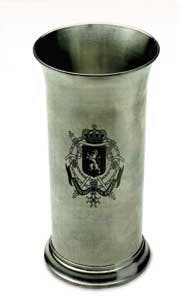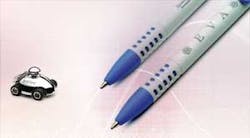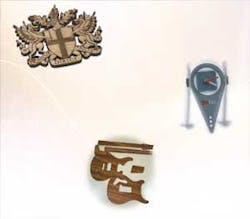by Gary Sheriff
Match the laser marking technology to the workstation
Not long ago, the galvanometer-based (galvo), lamp-pumped YAG laser was the only option for marking drill bits, turbine blades, and other industrial products. But lasers have come a long way in the last 10 to 15 years. Technology has opened the door to a more competitive playing field, and the role of the YAG laser in the marking world has changed dramatically as a result. Now, industrial users of markers have more flexibility in selecting the right combination of technology, beam, and work-station for their specific needs.
Technology
But where does one begin? Microsoft created a sea-shift in the industry by introducing the first useful version of Windows in the mid-1990s—enabling operators to control their lasers with a user-friendly screen, versus the complex DOS programming. As the technology evolved, so did the market landscape, bringing with it a host of laser technologies for industrial marking with top precision and speed.
YAG-type lasers are still quite high in demand in numerous industries, with needs ranging from deep engraving molds to sensitive backlit panel marking, to more traditional applications such as marking components for the automotive, electronic, medical, and aerospace industries. The Department of Defense recently—and perhaps inadvertently—created additional demand for laser systems with the unique identification (UID) program, a 2004 parts traceability mandate. This requires a permanently marked 2D matrix containing part traceability information, written with a specific syntax and applied to a part by direct part mark (DPM) or via tag or label materials. Lasers are not the only method for meeting the mandate, but they are certainly one of the best methods.
The original lamp-pumped YAG laser appeared in the early 1970s and was the common system for the next two decades until diode pumping technology improved and became more prevalent in the 1990s. Lamp-pumped lasers are still available, but they produce a larger heat byproduct than today's lasers and require both internal and external water chillers for cooling. They also require 220V and three phase electrical power—a more demanding power scheme than modern lasers, which can be easily run in a home environment. The lamp-pumped system has a niche for applications that need pure, raw power regardless of beam quality, such as deep engraving into metals. While most lasers can produce metal-engraved results as deep as 0.015 in., the lamp-pumped system may have an advantage in terms of processing time because its spot size is generally larger.
Otherwise, it is the diode-pumped laser and fiber laser that are now more commonly used, offering maximum efficiency with the convenience of operating on standard electricity. Spot sizes with these types of lasers are such that characters just slightly larger than the period at the end of this sentence can be marked with very sharp, crisp clarity when magnified with a 10× eye loupe. Diode-pumped systems come in a variety of lasers at different wavelengths, though the fundamental 1064nm wavelength is the most popular for industrial marking.
Applications
The three lasers in this realm—YAG, Vanadate, and Yb (ytterbium) fiber—all perform similar functions: creating contrasting results on the surface of (or directly into) metals and marking some plastics such as polycarbonates. One difference among these lasers is pulse width. The YAG, at higher Q-switch settings, has a larger pulse width that yields more average power than a Vanadate, translating to smaller processing time for creating black marks on metal surfaces—a key advantage. But it can also pose a problem for certain applications, such as creating a non-corroding surface mark on metal. If the metal becomes too hot during the marking process, it may lose its non-rusting properties. In this case, the Vanadate laser with its smaller pulse width may be a better fit, allowing the use of low power and repeated start sequences to create the mark without overheating the part. For the same reasons, Vanadate lasers may also be better suited for marking plastics that burn quickly.
The Yb fiber laser, introduced for marking in the late 1990s, uses diodes similar to those in the diode-pumped YAG or Vanadate, but in this case, multiple diodes are remotely mounted in the power supply and energized to a small percentage of maximum potential, projecting energy through a fiber optic cable that connects to a beam steering device such as a galvo. The fiber optic cable is doped with ytterbium, an element that gives the fiber laser its unique wavelength, which is similar to the YAG's 1064nm. Mirrors, like those used in the YAG and Vanadate resonator design, are not necessary, and therefore the design becomes a bit more simplified. The pulsing device is not a Q-switch but its performance is very similar. That should not be a concern, only something to be aware of when processing samples.
Delivery system/workstation
When choosing the right laser solution for your marking needs, technology and application will only get you so far. The final phase is choosing the beam delivery system and appropriate workstation. There are many options depending upon level of automation, but comparing a galvo to a flatbed workstation lays a solid foundation.
In the past, YAG lasers were sold strictly as galvo-based systems, while flatbeds were specific to CO2 machines. Both have their benefits for specific needs. A galvo workstation, for instance, typically has speed advantages for high-volume processing. The process area in a traditional galvo-driven laser is dictated by lens selection and can vary from 1 in. to 12×12in. Higher energy densities and better resolutions are achieved with smaller lens selections, but at a cost of focus depth and process area. The challenge lies in accurately marking a ruler or scale, an application that requires high precision. Though a flat field (F-theta) lens is typically used, there can be angular distortion the further from the center the laser marks within the process area. To reduce these inaccuracies, smaller lenses are used and motion tables are designed into the system to move the part from tile to tile as defined by the actual process area.
Once the laser completes marking all artwork within this field, the motion table moves until the subsequent process field—or tile—is adjacent to the previously marked field, much like tiles sitting next to each other on a kitchen floor. Should the artwork cross tiles, precision motion tables can compensate and reduce the possibility of unmatched lines between tiles. But adding motion tables, especially precision motion tables, will substantially increase system costs and add a level of complexity to the software.
The flatbed workstation employs a flying optic beam delivery. Its large table essentially becomes the entire process area, enabling seamless marking in a large field without requiring motion tables. Because the lens does not determine the process field, the final focusing optic can be one that is favorable to giving the highest energy density and smallest spot sizes. This is typically a lens with a short focal distance—similar to using an 80–100mm lens on a galvo-based system—allowing a high energy density with high resolutions, but perhaps at the cost of focus depth when marking domed or round parts. As with a galvo system, a rotary indexing device can be used to overcome these challenges. Associated table or process field sizes vary depending upon manufacturer, but, regardless of table size, the flying optic beam delivery ensures beam perpendicularity. If the table is flat relative to the laser head, angular distortion will not offset marking accuracies.
Because it uses a Windows printer driver, a flatbed system can be operated in a way similar to printing a piece of paper on a standard printer. Commercially available software such as Corel Draw, AutoCAD, or even BarTender for creating UID codes can be used to program and easily control the laser by printing the file. This is a distinct advantage over galvo-driven lasers, which require specialized software to drive the mirrors.
Combination tools
Still not sure which is best for you? Don't forget that in today's laser market, choice and flexibility are king. Some manufacturers seek to give you the best of both worlds. Trotec Laser, for instance, with its FineMarker, was one of the first companies to mount a YAG type laser to the back of a flatbed chassis so that programs used to operate an existing flatbed CO2 laser could also be run across platforms. Compared to galvo systems, this frees users from working with proprietary programs provided by the vendor, which requires designing files in commercially available packages, then importing them into the galvo software—a cumbersome process with a steep learning curve. An added bonus of the merged solution: a larger workspace, without the high costs.
With so many options currently on the market, the task of selecting a laser marking system can seem daunting. But it's the wide range of options that actually makes choosing a solution easier than ever. Simply mix and match to find the best fit for your volume, materials, and applications. And never discount the personal touch—be sure to consider salesmanship and product service and support. If done right, you'll be directed to the best laser and workstation for the job from the get go.
Gary Sheriff ([email protected]) is a senior consultant for Trotec Laser (Ypsilanti, MI; www.trotec.net) and teaches laser classes.





